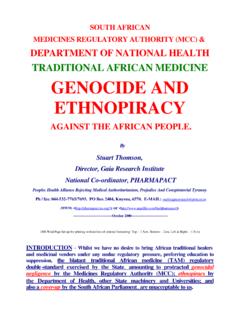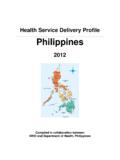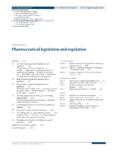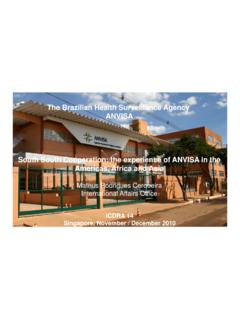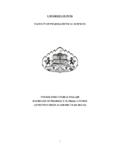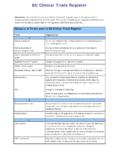Transcription of Medicines regulation - WHO
1 567 WHO Drug Information Vol. 30, No. 4, 2016 Medicines regulationComparison of Medicines legislation in the East African CommunityEfficient and aligned regulatory systems are crucial in ensuring access to medical products of assured quality. However, marketing authorizations of needed products are often delayed as researchers and manufacturers must navigate multiple regulatory requirements to register their products across the East African Community (EAC), efforts are under way for harmonization of technical requirements for Medicines regulation .
2 This article presents a comparison of legal and regulatory frameworks for the regulation of Medicines in EAC partner states. The findings show some commonalities but also differences and gaps, underlining the need for convergence towards a common Medicines regulatory framework in line with international African CommunityThe East African Community (EAC) was established in 1999 among the Republics of Kenya, Uganda, Rwanda, Burundi and the United Republic of Tanzania. With a population of million people in 2015 it is home to approximately 14% of the population of the African continent.
3 Life expectancies are below the global average, and all EAC partner states except Kenya are low-income countries according to the World Bank classification (Table 1).This article was authored by Mr. Hiiti B Sillo, Tanzania Food and Drugs Authority (TFDA), with input from Mr Sunday Kisoma, TFDA, and Mrs Monika Zweygarth. We thank Professor Eliangiringa Kaale and Professor Veronica Mugoyela from Muhimbili University of Health and Allied Sciences, Tanzania, and Dr Lembit R go from the Council for International Organizations of Medical Sciences (CIOMS), Switzerland, for helpful comments on the manuscript.
4 Table 1: Demographic characteristics of EAC partner statesPartner stateLand size, km3 World Bank dataPopulation, million World Bank data, 2015 Gross domestic product (GDP), million US$ World Bank data 2015 Gross national income (GNI) per capita*, US$ (World Bank data 2015)Life expectancy at birth**, years (WHO data, 2015)Kenya569 3981 340 855 895910 096700 369670 085260 * The World Bank defines low-income economies as those with a GNI per capita of up to US$ 1 025. Lower middle-income economies are those with a GNI per capita of US$ 1 026-4 035.
5 ** Global average 2015: years. Medicines regulation WHO Drug Information Vol. 30, No. 4, 2016568 Medicines regulatory harmonizationHarmonization initiatives for regulation of Medicines started in 1990 when the Medicines regulators and the research-based industry of Europe, Japan and United States of America established the International Conference on Harmonization of Technical Requirements for Registration of Pharmaceuticals for Human Use (ICH, now known as the International Council on Harmonisation of Technical Requirements for Registration of Pharmaceuticals for Human Use).
6 The objectives of ICH are to improve the efficiency of drug development and registration processes. To date, ICH has published guidelines in all areas of Medicines regulation including 12 quality guidelines, 11 safety guidelines, 18 efficacy guidelines and 8 multidisciplinary guidelines (1). One example of a functioning and successful regional harmonization initiative is that implemented by the European Union (EU), which offers several registration pathways (2). Under the EU centralized procedure, pharmaceutical companies submit a single marketing authorization application to the EMA.
7 The relevant Committee carries out a scientific assessment of the application and gives a recommendation on whether or not to grant a marketing authorization. Once granted by the European Commission, the centralized marketing authorization is valid in all EU member states. Under the decentralized procedure, applications are submitted and subsequently approved simultaneously in several member states, one of which is designated as the reference member state . Under the mutual recognition procedure, which is applicable to the majority of conventional medicinal products, already existing national marketing authorizations are recognized by one or more EU member states.
8 National authorizations are still available for medicinal products to be marketed in one EU member state regional harmonization initiatives are under way in the Association of the Southeast Asian Nations (ASEAN), the Gulf Cooperation Council (GCC), the Pan American Network for Drug regulatory Harmonization (PANDRH) and the Southern African Development Community (SADC).EAC Medicines regulation harmonizationChapter 21, Article 118 of the EAC Treaty (3) provides for co-operation on health and specifically asks partner states to harmonize drug registration procedures so as to achieve good control of pharmaceutical standards without impeding or obstructing the movement of pharmaceutical products, and hence facilitate access to pharmaceutical products within the Community.
9 This is expected to increase access to medicinal products needed to treat health conditions that are prevalent in the region. The beginnings of harmonization of Medicines regulation in the EAC region go back to 2001, when the technical requirements for registration of veterinary drugs were approved by the EAC national Medicines regulatory authorities (NMRAs) as exemplified by the Tanzanian guidelines. This was followed by a situation analysis of partner states (4), which highlighted some differences in regulatory capacity and scope of activities as well a lack of institutional mechanisms to share information for example on drug registration or product recalls.
10 The EAC Medicines regulation Harmonization (MRH) Programme was launched in March 2012. It was the first programme to receive funding under the African Medicines regulatory 569 WHO Drug Information Vol. 30, No. 4, 2016 Medicines regulationHarmonization (AMRH) initiative through a trust fund established by an agreement between the Bill & Melinda Gates Foundation and the World Bank. The ultimate goal of the EAC MRH programme is to establish a harmonized regulatory system in the region that enables approval of Medicines through various regulatory pathways, similar to the regulation model implemented by the EU Member States.











